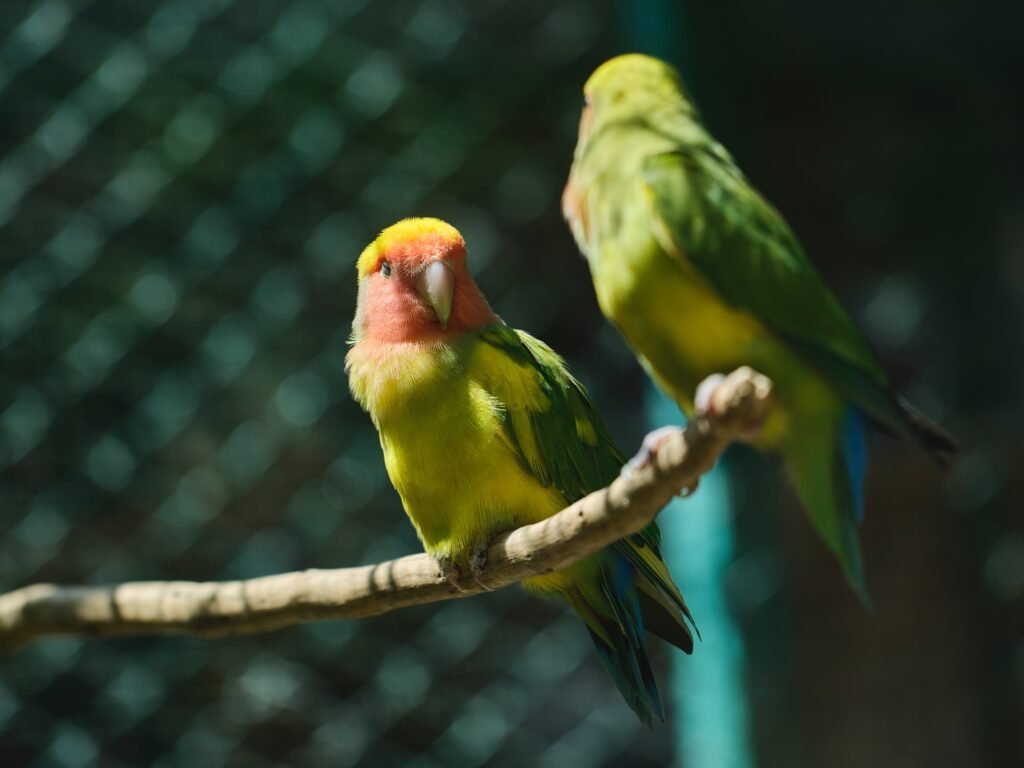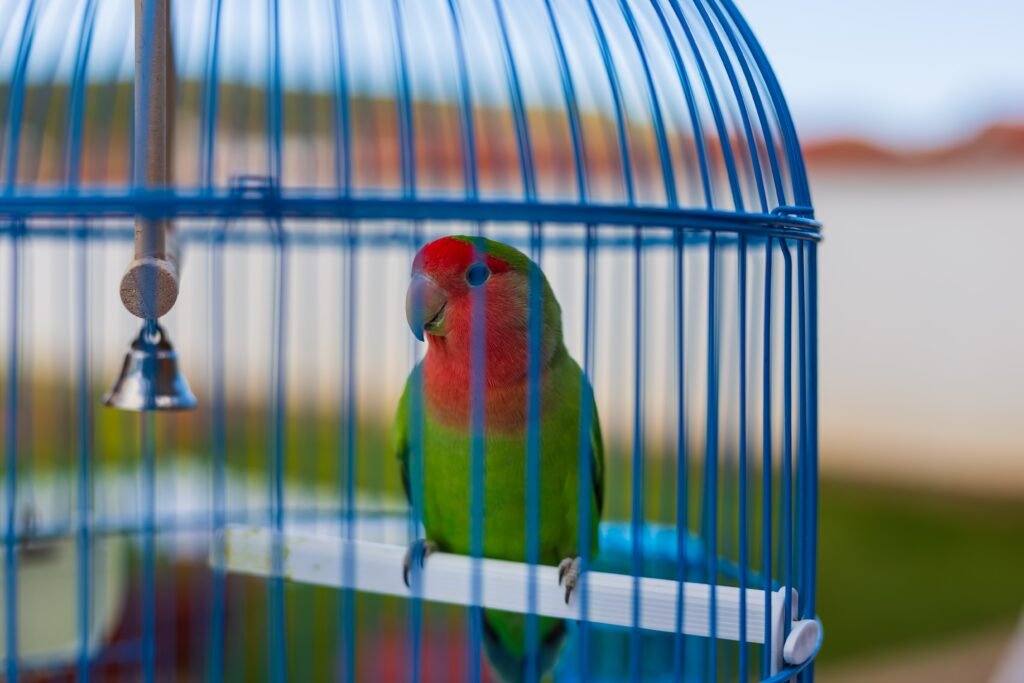Birds can make wonderful companions, bringing joy and entertainment to our lives. Two popular choices for pet birds are lovebirds and parakeets. Both species have their unique characteristics and qualities that make them appealing to bird lovers. In this article, we will explore the differences and similarities between lovebirds and parakeets to help you decide which bird might be the perfect pet for you.
Lovebirds
Lovebirds are small, social birds that belong to the genus Agapornis. They are native to Africa and are known for their affectionate nature and strong pair bonding. Here are some key characteristics of lovebirds:
- Size and Appearance: Lovebirds are relatively small birds, usually measuring around 5 to 7 inches in length. They have a stocky build, with a short tail and a strong beak. Lovebirds come in a variety of vibrant colors, including green, blue, yellow, and peach-faced. Their colorful plumage adds beauty and charm to any bird lover’s home.
- Social Behavior: Lovebirds are highly social birds and thrive on companionship. They form strong bonds with their mates and can become attached to their human caregivers. These birds enjoy being part of a flock and require daily interaction to prevent boredom and loneliness. If you are looking for a bird that enjoys interaction and affection, lovebirds may be the right choice for you.
- Vocalizations: Lovebirds are known for their chirping and squawking sounds. While their vocalizations are not as loud as some other bird species, they can be quite vocal, especially when they feel happy or excited. Lovebirds use their voice to communicate with their flock members and express their emotions. If you live in an apartment or have close neighbors, it’s essential to consider the noise level of lovebirds.
- Intelligence and Trainability: Lovebirds are intelligent birds and can be trained to perform various tricks and behaviors. With patience and positive reinforcement, they can learn to mimic sounds, step onto your hand, and even solve simple puzzles. Training can be a fun and rewarding experience for both you and your feathered friend. Lovebirds have the ability to learn and adapt quickly, making them a delight to train and interact with.
- Diet: Lovebirds require a well-balanced diet that consists of high-quality birdseed, fresh fruits, vegetables, and occasional treats. It’s important to provide them with a varied and nutritious diet to ensure their overall health and well-being. Lovebirds are also known to enjoy chewing on fresh branches and leaves, which helps keep their beaks in good condition.
- Grooming: Lovebirds are meticulous groomers and spend a significant amount of time preening their feathers. Regular bathing or misting is essential to keep their feathers clean and healthy. Providing a shallow dish of water or a bird bath for them to bathe in will help maintain their plumage and prevent feather-related health issues.
Parakeets
Parakeets, also known as budgerigars or budgies, are small, intelligent birds native to Australia. They are one of the most popular pet bird species worldwide. Let’s take a closer look at the characteristics of parakeets:
- Size and Appearance: Parakeets are slightly larger than lovebirds, measuring around 7 to 8 inches in length. They have a slender build, a long tail, and a distinctive hooked beak. Parakeets come in various color mutations, including green, blue, yellow, and albino. Their vibrant colors and graceful flight make them a visually appealing addition to any bird lover’s home.
- Playful and Active: Parakeets are highly active birds that enjoy exploring their surroundings and engaging in play. They are curious and love to investigate toys, mirrors, and interactive objects. Providing a stimulating environment with plenty of toys and perches is essential to keep them mentally and physically stimulated. Parakeets are agile flyers and require regular exercise outside of their cage to maintain their physical health.
- Talking Abilities: Parakeets are known for their impressive mimicry skills and ability to learn words and phrases. While not all parakeets will develop extensive vocabularies, many can learn to mimic sounds, whistle tunes, and even have short conversations with their owners. If you are looking for a bird that can entertain you with its vocal talents, a parakeet might be a great choice. Their ability to mimic human speech makes them a fascinating and entertaining pet.
- Easy Maintenance: Parakeets are relatively low-maintenance pets compared to larger parrot species. They require a clean cage, fresh water, a proper diet, and regular interaction with their owners. With proper care and attention, they can lead long and healthy lives. Parakeets are adaptable birds that can thrive in a variety of living situations, making them suitable for both beginner and experienced bird owners.
- Diet: Parakeets have specific dietary requirements that include a combination of high-quality birdseed, fresh fruits, vegetables, and occasional millet sprays. It’s important to provide them with a balanced diet to support their overall health and prevent nutritional deficiencies. Parakeets also enjoy chewing on pieces of cuttlebone or mineral blocks to keep their beaks trimmed and healthy.
- Grooming: Parakeets are excellent groomers and spend a significant amount of time preening their feathers. However, they may require occasional assistance in trimming their nails and beak. Providing a cuttlebone or mineral block for them to chew on can help naturally wear down their nails. Regular feather checks and grooming sessions will ensure their plumage remains in pristine condition.
Making the Choice
Deciding between lovebirds and parakeets ultimately depends on your personal preferences and lifestyle. Consider the following factors when making your decision:
- Space: Lovebirds and parakeets both require adequate space to fly and exercise. Ensure that you have enough room to accommodate a suitable cage and provide a safe environment for your bird to spread its wings. Lovebirds tend to be more active climbers and require vertical space, while parakeets need horizontal space for flying.
- Noise Level: While both lovebirds and parakeets can vocalize, lovebirds tend to be a bit louder and more prone to squawking. If you live in a quiet neighborhood or have noise restrictions, a parakeet might be a more suitable choice. Parakeets are generally quieter and produce softer vocalizations.
- Interaction and Bonding: Lovebirds are known for their strong pair bonding and the ability to form close relationships with their human caregivers. If you are looking for a bird that will shower you with love and affection, a lovebird might be the perfect pet for you. Parakeets can also form strong bonds with their owners but may not be as affectionate as lovebirds.
- Talking Abilities: If you are fascinated by a bird’s ability to mimic sounds and talk, a parakeet might be the right choice. While lovebirds can learn a few words, parakeets are generally more adept at imitating human speech. Parakeets have a remarkable ability to mimic various sounds and voices, making them entertaining companions.
- Activity Level: Parakeets are highly active birds that require mental and physical stimulation to thrive. If you have the time and energy to engage in regular play and interaction, a parakeet could be a great companion. Lovebirds also need mental stimulation but may not require as much physical activity as parakeets.
Remember, both lovebirds and parakeets can live for 10 to 15 years or even longer with proper care. Before bringing a bird into your home, ensure that you are ready for the long-term commitment and responsibility that comes with caring for these beautiful creatures.
In conclusion, whether you choose a lovebird or a parakeet, both birds have their unique charms and qualities that can bring immense joy to your life. Consider your preferences, lifestyle, and the specific needs of each species to make an informed decision. Whichever bird you choose, be prepared to provide a loving and nurturing environment and enjoy the delightful companionship they offer.
FAQ: Lovebirds vs Parakeets: Which Bird Makes the Perfect Pet?
1. What are the key characteristics of lovebirds?
- Size and Appearance: Lovebirds are small birds, measuring around 5 to 7 inches in length. They have a stocky build and come in various vibrant colors.
- Social Behavior: Lovebirds are highly social birds that form strong bonds with their mates and enjoy human interaction.
- Vocalizations: Lovebirds are known for their chirping and squawking sounds, although not as loud as some other bird species.
- Intelligence and Trainability: Lovebirds are intelligent and can be trained to perform tricks and behaviors.
- Diet: Lovebirds require a well-balanced diet of birdseed, fresh fruits, vegetables, and occasional treats.
- Grooming: Lovebirds are meticulous groomers and require regular bathing or misting to keep their feathers clean.
2. What are the characteristics of parakeets?
- Size and Appearance: Parakeets are slightly larger than lovebirds, measuring around 7 to 8 inches in length. They have a slender build and come in various colors.
- Playful and Active: Parakeets are highly active birds that enjoy exploring and playing with toys.
- Talking Abilities: Parakeets are known for their mimicry skills and ability to learn words and phrases.
- Easy Maintenance: Parakeets are relatively low-maintenance pets compared to larger parrot species.
- Diet: Parakeets require a balanced diet of birdseed, fruits, vegetables, and occasional millet sprays.
- Grooming: Parakeets are excellent groomers but may require occasional assistance in trimming their nails and beak.
3. What factors should I consider when choosing between lovebirds and parakeets?
- Space: Consider the space you have available for a suitable cage and the specific needs of each species.
- Noise Level: Lovebirds tend to be louder and more prone to squawking, while parakeets are generally quieter.
- Interaction and Bonding: Lovebirds have a strong pair bonding and can form close relationships with their human caregivers. Parakeets can also form bonds but may not be as affectionate.
- Talking Abilities: Parakeets are generally more adept at imitating human speech compared to lovebirds.
- Activity Level: Parakeets require more mental and physical stimulation compared to lovebirds.
4. How long do lovebirds and parakeets live?
Both lovebirds and parakeets can live for 10 to 15 years or even longer with proper care and attention.


